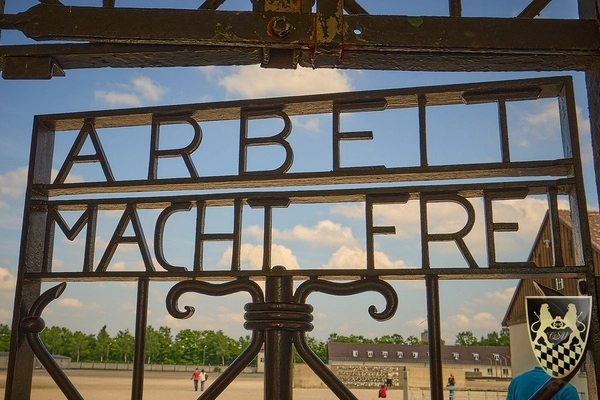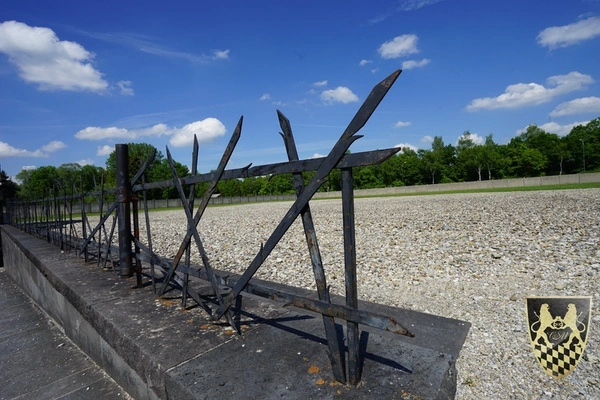Dachau Concentration Camp Tour: Essential Guide for Visitors
Planning a Dachau Concentration Camp Tour? This guide covers everything you need to know about your Dachau concentration camp tour, including its historical importance, how to get there, opening hours, and tips for a respectful, meaningful visit.
Key Takeaways
-
Dachau Concentration Camp, established in 1933, evolved into a site of immense suffering, becoming a model for other Nazi camps, and today serves as a memorial for victim remembrance and education.
-
Luxury tours from Munich to Dachau provide a comfortable and insightful experience for visitors, with private driver guides offering detailed historical context and logistical convenience.
-
The Dachau Concentration Camp Memorial is accessible year-round, with free admission, educational resources, and facilities that ensure a respectful and informative visit for all guests.
Overview of Dachau Concentration Camp

Dachau Concentration Camp was established in 1933, initially serving as a detention center for political prisoners. Over time, it evolved into a model for other concentration camps built, expanding its grim reach to include various groups deemed undesirable by the Nazi regime. For more than a decade, the camp’s brutal conditions and systematic cruelty became a hallmark of the Nazi concentration camp system.
Liberated by U.S. forces in April 1945, Dachau revealed the horrific realities of life within its confines. The liberation of Dachau marked the end of its role as a site of oppression and suffering, but the memories of those who endured its terrors remain deeply etched in history.
Today, the Dachau Concentration Camp Memorial serves as a place of remembrance and education, attracting visitors from around the world who seek to honor the victims and learn from the past.
Luxury Tour from Munich to the Dachau concentration Camp with Driver GUide

Luxury tours from Munich to Dachau Concentration Camp offer a comfortable and informative way to explore the historical site. Travel in style with a private driver guide, available in a sedan, limousine, or luxury van accommodating up to eight people. This personalized service provides detailed historical insights and a seamless journey from start to finish.
These tours offer both convenience and a deeper understanding of the concentration camp’s historical context. The driver guide handles all logistics, letting you focus on the profound experience of visiting the Dachau Concentration Camp Memorial.
Choosing a private driver for a concentration camp tour in and around Munich or opting for a sightseeing tour with a limousine or van ensures a memorable and respectful visit.
Historical Background of Dachau Concentration Camp
Dachau was established on March 22, 1933, making it the first concentration camp created by the Nazis. Initially intended to imprison political opponents, particularly those who opposed Nazi ideology, Dachau quickly became a place of terror and inhumanity. Under the brutal command of Theodor Eicke, the camp’s regulations were harshly enforced, leading to significant expansions and the imprisonment of approximately 67,665 registered prisoners by 1945.

The liberation of Dachau by U.S. forces in April 1945 marked the end of its horrific operations. The camp’s history is a stark reminder of the extent of political oppression and terror during the Third Reich.
Today, the Dachau Concentration Camp Memorial serves to educate visitors about these dark times and to honor the memories of those who suffered and perished there.
The Dachau Concentration Camp Memorial Site
Inaugurated in 1965, the Dachau Concentration Camp Memorial Site stands as a testament to the importance of remembrance and documentation. The site emphasizes the need to remember the atrocities committed and to educate future generations about the horrors of the Holocaust. Each year, the dachau memorial site attracts approximately 800,000 visitors who come to pay their respects and learn about the camp’s history.
The memorial site features a visitors center with comprehensive information about the camp’s history and various exhibitions documenting the prisoners’ experiences.
Walking through the former camp grounds allows visitors to reflect on the past and the importance of remembering the atrocities committed during this dark chapter of history.
Planning Your Visit to Dachau Concentration Camp Memorial

Preparing for a visit to the Dachau Concentration Camp Memorial is essential for a meaningful and respectful experience. The memorial site is easily accessible from Munich, with frequent train services to Dachau station. From there, a short bus ride or drive will take you directly to the memorial entrance. For those traveling by car, parking is available at the site for a small fee.
The Dachau Concentration Camp Memorial is open daily, with specific hours varying by season, so it is advisable to check ahead before your visit. Admission to the memorial is free, although there may be a fee for special exhibitions or for parking.
The site offers facilities and services, including a visitors center, information desk, and rest areas, to ensure a comfortable and informative meeting point visit.
How to Get There
Dachau is located approximately 12 miles (20 kilometers) from Munich, making it a convenient destination for a day trip. The S2 train from Munich to Dachau takes about 25 minutes, and upon arrival at Dachau train station, bus 726 will take you directly to the memorial entrance. Public transportation provides a viable and efficient option for visitors with this seamless connection.

For those who prefer to drive, the journey to Dachau involves taking the A8 and A9 highways, with clear signage directing visitors to the memorial site. Parking is available at the site for €3 per car, though spaces can fill up quickly during peak times.
Reaching the Dachau Concentration Camp Memorial is straightforward and well-supported by local infrastructure, regardless of your mode of transport.
Opening Hours and Tickets
Operating daily from 9:00 AM to 5:00 PM, the Dachau Concentration Camp Memorial allows visitors ample time to explore the site and its exhibitions. It is important to note that the memorial is open year-round, but specific hours may vary depending on the season, so checking the official website before your visit is recommended.
Admission to the memorial site is free, and no pre-registration is required. Audio guides can be rented at the visitors center for €4.50, offering additional context and information as you explore the site.
Parking fees are also minimal, with €3 for cars and motorcycles, and €5 for larger vehicles like buses or campers.

Facilities and Services
The Dachau Concentration Camp Memorial includes a well-equipped visitors center with extensive information about the camp’s history. Guests can visit the information desk upon arrival to receive brochures, maps, and other resources for navigating the memorial site. The visitors center also provides details about guided tours and special exhibitions, ensuring that visitors have a comprehensive understanding of what to expect during their visit.
The memorial site includes rest areas and designated spots for reflection throughout the grounds, in addition to the information desk. These areas provide visitors with opportunities to take breaks and process the emotional weight of the historical events commemorated at Dachau. The facilities are designed to make the visit as informative and comfortable as possible, accommodating the needs of all visitors.
Guided Tours and Audio Guides
Maximize your visit to Dachau by taking advantage of the guided tours and audio guides available at the memorial site. These resources provide structured experiences and in-depth insights into the concentration camp’s history and significance. Both guided tours with knowledgeable guides and self-guided visits with audio guides offer valuable context and enhance your understanding of the site.
Experienced guides conduct guided tours in multiple languages, answering questions and providing detailed explanations. For those who prefer exploring at their own pace, audio guides can be rented at the visitors center, enabling you to delve into the site’s history according to your schedule and interests during a walking tour.

Guided Tours
A guided tour at Dachau Concentration Camp Memorial is highly recommended for gaining a comprehensive understanding of the site’s history and significance. Suitable for visitors over 13 years old, these tours last approximately 2.5 hours and cost €4.00 per person. Purchase tickets at least 30 minutes before the tour starts, with meeting points typically at the visitors center.
Guided tours in multiple languages cater to the diverse international visitors who come to Dachau each year. Whether part of a large group or individual visitors, these tours offer a structured and informative exploration of the former concentration camp’s historical buildings and grounds.
Self-Guided Visits with Audio Guides
For those preferring to explore at their own pace, self-guided visits with audio guides are an excellent option. Audio guides, available in 14 languages including English, German, and Spanish, can be rented at the visitors center for a modest fee. This availability ensures visitors from various backgrounds can access detailed information about the site’s history.
An audio guide allows you to take your time and reflect on the exhibits and historical structures without the constraints of a scheduled tour. Audio guides offer comprehensive explanations and context for each part of the memorial, making it easy to navigate and understand the significance of what you see.
Key Sites and Exhibitions at Dachau Memorial

The Dachau Concentration Camp Memorial features key sites and exhibitions offering deep insights into the camp’s history and the experiences of its prisoners. Visitors can explore historical buildings, the main permanent exhibition, and various special exhibitions highlighting different aspects of the camp’s history. Each element contributes to a comprehensive understanding of the atrocities committed and the importance of remembrance.
The main exhibition focuses on the prisoners’ journey, from their arrival at Dachau to their daily lives and eventual liberation or death. This exhibition, along with the historical buildings and special events, offers a multifaceted view of the camp’s history and its global impact.
Historical Buildings and Grounds
The Dachau Memorial features several significant historical structures reflecting the camp’s operations and the prisoners’ conditions. Key sites like the barracks and the crematorium provide chilling insights into daily life and death within the camp. Walking through these buildings gives you a sense of the harsh realities faced by those imprisoned here.
The barracks illustrate overcrowded and inhumane living conditions, while the crematorium serves as a stark reminder of the Nazis’ systematic extermination. These historical buildings stand as a testament to the suffering endured and a powerful reminder of the need for vigilance against future atrocities.

Permanent Exhibition
The permanent exhibition at the Dachau Concentration Camp Memorial offers a detailed account of the prisoners’ experiences, from their arrival to their daily lives and eventual fate. It includes artifacts and documents providing poignant insights into the lives of those imprisoned here. Multimedia presentations and historical panels enrich the narrative, making the exhibition accessible and engaging for all ages.
The exhibition educates and evokes deep emotional responses, helping visitors connect with the prisoners’ personal stories. Presenting these narratives compellingly, the permanent exhibition honors and preserves the victims’ memories.
Special Exhibitions and Events
Besides the permanent exhibition, the Dachau Memorial hosts temporary exhibitions and special events offering updated perspectives on the camp’s history. These exhibitions focus on specific themes related to the Holocaust and Nazi crimes, engaging visitors with contemporary discussions and reflections.
Special exhibitions enhance visitors’ understanding of historical events and the ongoing importance of remembrance and education. Addressing contemporary themes ensures that the lessons of Dachau remain relevant and impactful for future generations.
Informational Panels and Augmented Reality
Throughout the Dachau Concentration Camp Memorial Site, visitors will find numerous informational panels placed at significant spots. These panels provide a wealth of information about the camp’s history, including its establishment, the daily life of prisoners, and the liberation of the camp. Available in multiple languages, including English, German, and French, these panels ensure that visitors from around the world can access detailed historical insights.
In addition to the informational panels, the memorial site offers an augmented reality experience that brings history to life in a unique and engaging way. By downloading the ARt app on their smartphones or tablets, visitors can explore the camp in a virtual environment, gaining a deeper understanding of the camp’s layout and history. This augmented reality experience allows visitors to see the camp as it was during its operation, with virtual reconstructions of buildings and structures that no longer exist.
The app also provides additional information and multimedia content, such as videos and audio recordings, to enhance the visitor experience. This innovative approach helps bridge the gap between past and present, offering a comprehensive and immersive way to learn about the Dachau Concentration Camp.
Practical Tips for Visiting Dachau Concentration Camp

Careful planning is essential for a respectful and meaningful visit to the Dachau Concentration Camp Memorial. Spring or fall is the best time to visit, with mild weather and smaller crowds compared to summer. Comfortable walking shoes and layered clothing are advisable due to the outdoor nature of the site and varying weather conditions.
The memorial site is well-considered for accessibility, with wheelchairs and e-scooters available for those needing assistance. Maintaining a respectful demeanor throughout your visit is crucial, as the site is a place of remembrance and reflection.
Refrain from loud noises and disruptive behavior to honor the solemn nature of the memorial.
Best Time to Visit
Visiting the Dachau Memorial in the early morning or late afternoon helps avoid large crowds. Spring offers fewer crowds but occasional rain, while autumn provides cooler weather and beautiful foliage.
Weekdays are generally less crowded than weekends, offering a more peaceful visit. Choosing the right time ensures a more contemplative and less hurried experience, letting you fully absorb the site’s significance.
What to Wear and Bring
Dressing appropriately for a visit to the Dachau Concentration Camp Memorial is crucial for comfort. Layered clothing is recommended to adjust to changing weather conditions, especially during colder months when heavy outdoor clothing is necessary. Comfortable walking shoes are essential, as you will be navigating gravel paths and uneven surfaces throughout the site.

Consider bringing a water bottle and snacks, as food options may be limited within the memorial grounds. These small preparations can make your visit more comfortable and allow you to focus on the educational and reflective aspects of the experience.
Accessibility and Visitor Etiquette
The Dachau Memorial is committed to being accessible to all visitors. Wheelchairs and e-scooters are available to assist those with mobility issues. However, some areas may not be fully accessible due to preservation laws, so it’s important to plan ahead and inquire about accessibility options at the visitors center.
Maintaining respectful behavior is paramount when visiting a site of such historical significance. Visitors should dress appropriately and conduct themselves in a manner that honors the memory of those who suffered here. Refraining from loud noises and disruptive behavior ensures a solemn and respectful atmosphere for all visitors.
Visiting with Children
Visiting the Dachau Concentration Camp Memorial Site with children can be a challenging but ultimately rewarding experience. The site is generally suitable for children aged 12 and above, but parents are advised to exercise discretion when deciding whether to bring younger children. The sensitive nature of the site’s history requires careful consideration and preparation.
The memorial site offers a range of resources and activities designed to help children understand the history of the camp and its significance. Guided tours and educational programs are available, promoting empathy and tolerance while providing age-appropriate historical context. These programs are crafted to engage young minds and foster a deeper understanding of the atrocities committed during the Holocaust.
Parents are encouraged to prepare their children in advance for the visit, explaining the history of the camp and the importance of the memorial site. Accompanying children throughout the visit is crucial, providing guidance and support as they navigate the emotional and historical weight of the site.

The memorial site also offers amenities to accommodate families, including a cafeteria and restrooms. Planning the visit with regular breaks can help ensure a comfortable and reflective experience for both children and adults. Visiting the Dachau Concentration Camp Memorial Site with children can be a powerful educational opportunity, helping to instill values of empathy, understanding, and remembrance in the next generation.
Summary
Visiting the Dachau Concentration Camp Memorial is a powerful and educational experience that offers deep insights into one of the darkest chapters of human history. From understanding the camp’s historical significance to exploring its key sites and exhibitions, each aspect of the visit is designed to honor the memories of the victims and educate future generations. Whether you choose a guided tour or a self-guided visit with an audio guide, the memorial provides a comprehensive and respectful exploration of the past.
As you plan your visit, remember the practical tips to ensure a comfortable and meaningful experience. By preparing appropriately and maintaining a respectful demeanor, you can fully engage with the memorial’s offerings and reflect on the importance of remembrance. The Dachau Concentration Camp Memorial stands as a solemn reminder of the atrocities committed and serves to educate and inspire a commitment to never forget.
Frequently Asked Questions
How do I get to the Dachau Concentration Camp Memorial from Munich?
To reach the Dachau Concentration Camp Memorial from Munich, take the S2 train to Dachau train station, followed by bus 726 directly to the memorial entrance. Alternatively, you can drive, as parking is available on-site.
What are the opening hours of the Dachau Concentration Camp Memorial?
The Dachau Concentration Camp Memorial is open daily from 9:00 AM to 5:00 PM, but it is recommended to verify the official website for any seasonal changes.
Are guided tours available at the Dachau Memorial?
Guided tours at the Dachau Memorial are available in multiple languages, last approximately 2.5 hours, and cost €4.00. It is recommended to purchase tickets at least 30 minutes prior to the tour.
Can I visit the memorial on my own without a guide?
Yes, you can visit the memorial on your own with the option to rent audio guides at the visitor center, which are available in 14 different languages. This allows for a personalized experience while exploring the site.
Is the Dachau Memorial accessible for disabled visitors?
The Dachau Memorial is accessible for disabled visitors, providing wheelchairs and e-scooters; however, some areas may remain partially inaccessible due to preservation regulations.
